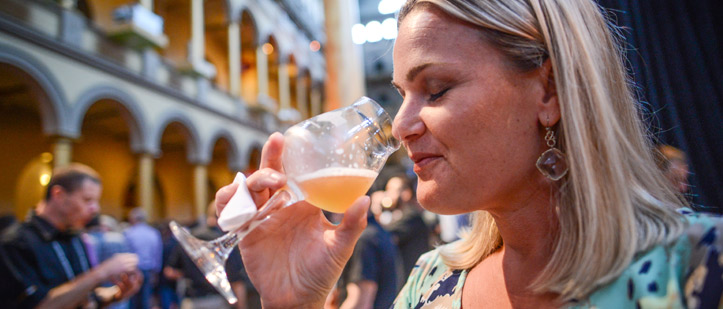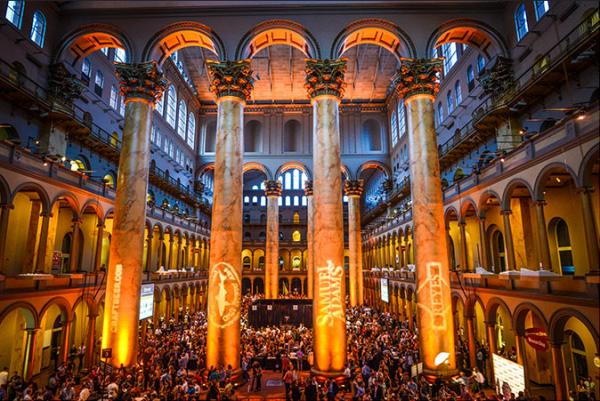SAVOR®: An American Craft Beer & Food Experience, one of the world’s largest beer and food pairing events, happens in a quick 48 hours. But, before the doors even closed, our notes for 2016 had already begun. So, just how do we get 76 small and independent craft brewers into one room with 152 craft beers and 46 menu items?
The SAVOR 2015 journey started in January with a lottery selection process for participating breweries and their beers. Once the beers were selected, each brewer sends two beers to Brewers Association home offices in Boulder, Colo., for a tasting session. This year, we received 130 beers for the tasting and notes on the remaining 22 that had not been brewed yet.
The Tasting
We divide the beers into two tastings and invite 15 or so palates to each tasting. We are not looking for beer judges here, rather culinary thoughts, flavors, memories, stories, and anything that will help us work toward a final menu. Everyone arrives and we cover the ground rules: no cell phones, no judging, no wrong answers, write down what first comes to mind, try and write with words we can read—and go.
 As everyone winds their way through, flavors are noted and when a palate challenging beer is reached, help is called in to offer more opinions. As we move along, any challenging beers or palate moving beers are saved for possible later tastings with food. After a short break, we reset the room and begin round two with new palates. Once we get through round two, we collect all the tasting notes and head back to plan the menu.
As everyone winds their way through, flavors are noted and when a palate challenging beer is reached, help is called in to offer more opinions. As we move along, any challenging beers or palate moving beers are saved for possible later tastings with food. After a short break, we reset the room and begin round two with new palates. Once we get through round two, we collect all the tasting notes and head back to plan the menu.
Beer and Food Pairing Discussions
The planning room includes: three chefs, a few cookbooks to reference, music and some more beer. In the next eight hours, we will go through each tasting sheet, highlight words and phrases, and by 2 a.m. we’ll have a 46 item-menu written for the 152 beers we are working with for SAVOR.
First, we start with broad groups like fish, meat, vegetarian, cheese and dessert. Then we move to the hardest and most fun part of the day, writing the menu. SAVOR truly starts with a blank piece of paper. Someone says salmon. Okay, how about some honey with the salmon? We need acid too, how about some lime? Okay, the honey-glazed salmon goes into the mix. What’s next? How about some game this year—venison. Okay, what beers need some iron?
Flipping through the tasting notes, we find some memories: eating summer corn on family’s front porch; a beer after working in the yard on a hot day; cinnamon rolls baking in the oven; burnt marshmallows at a campfire. We take those memories and think about foods that personify those memories: grilled corn, pickled vegetables, melon, toasted meringue.
All of these go into components for dishes. We repeat this process until we have 50 or so menu items. We then go through and remove a few that don’t line up with the overall flow. Once we get to 46, we call it a night just before 2 a.m.

Planning the Room
The next day, we look over the SAVOR menu one last time. The next step takes place on a large table. We spread out the individual tasting sheets and put each beer with a menu item. We balance the menu across the room. No two styles for the same dish, no two menu categories for the same brewer, no dish repeated more than three or four times.
Once we get everyone paired up, we start making tasting notes for each brewer so they know the how and why we created each pairing. We push the envelope for pairings quite a bit, espeically where we know the brewer will take a huge leap with us. For example, mushrooms and arborio rice with a barrel-aged imperial stout—we’re looking to take our guests palates and the pairings in unexpected directions.
Once all the pairings are made, we sync up with our caterer in Washington, D.C., who will execute the preparation and serving of over 100,000 bites of food. That’s correct, we serve over 50,000 pieces of food each night of SAVOR.
As SAVOR gets closer, we start sourcing the products and lining up our final counts for each dish. A test run trip is taken to D.C. to run through some of the more challenging pairings. A few tweaks are made to flavors and garnishes, salt levels and caramelization of proteins. Once this is done, we are set to go into the prep stage of the menu.
SAVOR Day-Of
As SAVOR arrives, just as we wrote the menu in one day, we now set up and execute first night in one day. Building three kitchens on site, placing beer and setting the room for 2,000 guests to mingle with craft beer and food all takes place before 5 p.m.

Similar to a restaurant, right before we open the doors, we do line up. Taste your food, know your pairing, a few housekeeping rules and it’s almost time to go.
Once the doors open, 2,000 guests come through ready to try this year’s craft beer selections and menu. Some new pairings are found, some experience new beer styles, some guests realize they do actually like a beer style they thought they did not.
After six months of work, seeing just one guest have a truly great moment and create their own pairing story with craft beer and food makes it all worthwhile.
CraftBeer.com is fully dedicated to small and independent U.S. breweries. We are published by the Brewers Association, the not-for-profit trade group dedicated to promoting and protecting America’s small and independent craft brewers. Stories and opinions shared on CraftBeer.com do not imply endorsement by or positions taken by the Brewers Association or its members.


Share Post